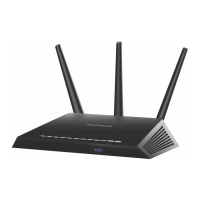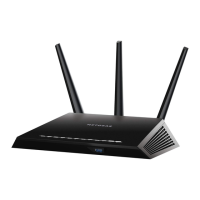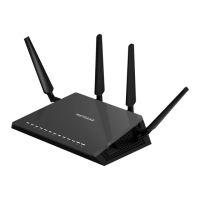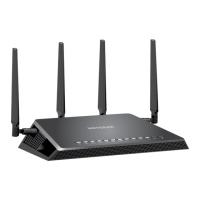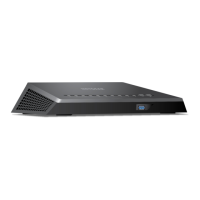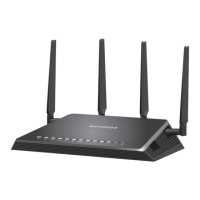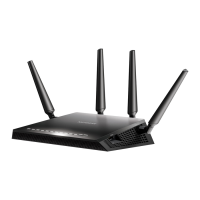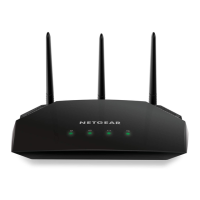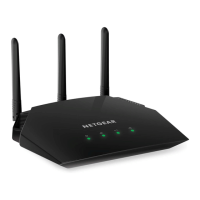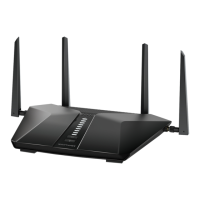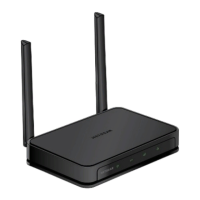Do you have a question about the NETGEAR R7000 and is the answer not in the manual?
| Brand | NETGEAR |
|---|---|
| Model | R7000 |
| WiFi Technology | 802.11ac |
| USB Ports | 1 x USB 3.0, 1 x USB 2.0 |
| Antennas | 3 external antennas |
| Beamforming | Yes |
| RAM | 256 MB |
| Flash Memory | 128 MB |
| Frequency Band | 2.4 GHz / 5 GHz |
| WiFi Speed | Up to 1900 Mbps |
| Processor | 1 GHz dual-core processor |
| Ethernet Ports | 5 (1 WAN & 4 LAN) |
| Security | WPA/WPA2 |
| Dimensions | 285 x 184.5 x 50 mm (11.22 x 7.26 x 1.97 in) |
| Weight | 750 g |
Guidance on selecting an optimal location for the router to maximize WiFi signal range.
Step-by-step instructions for connecting the router to the modem and power source.
Procedure for logging into the router's web interface using administrator credentials.
Step-by-step guide to using the Setup Wizard for automatic Internet configuration.
Manual configuration of Internet connection settings, including login requirements.
Configuring the router for Internet connections that do not require login credentials.
Configuring the router for Internet connections requiring ISP login information.
Setting up IPv6 Internet connections, including auto-detect and manual configuration.
Configuring IPv6 connection by allowing the router to auto-detect settings.
Setting up IPv6 connection using automatic configuration parameters.
Configuring an IPv6 connection using the 6rd tunnel protocol.
Configuring an IPv6 connection via a 6to4 tunnel.
Setting up IPv6 connection in pass-through mode, functioning as a Layer 2 switch.
Configuring a static IPv6 address and prefix length for the WAN interface.
Setting up an IPv6 connection using a DHCP server for address assignment.
Configuring an IPv6 connection using PPPoE authentication with ISP details.
Enabling bridge mode or configuring VLAN tag groups for specific network needs.
Using QoS to prioritize traffic for gaming and video streaming.
Prioritizing network traffic from local devices for lag-free online gaming.
Activating the Upstream QoS feature for improved gaming performance.
Creating rules to prioritize specific applications, games, or devices by MAC address.
Prioritizing Internet traffic for enhanced video streaming performance.
Creating rules to prioritize traffic based on keywords or domain names.
Creating rules to prioritize traffic for specific devices using their MAC addresses.
Configuring parental controls and web filtering levels for network devices.
Using access control features to manage which devices can connect to the network.
Blocking specific websites using keywords, either always or on a schedule.
Blocking specific Internet services or applications based on type or schedule.
Using ReadySHARE to access and share USB storage devices connected to the router.
Connecting to and accessing a USB storage device from a Mac computer.
Connecting to and accessing a USB storage device from a Windows computer.
Using ReadySHARE Vault for centralized, continuous backup of Windows computers.
Configuring Dynamic DNS for remote network access using a domain name.
Accessing USB storage devices connected to the router over the Internet.
Using the ReadyCLOUD service for remote access to USB storage devices.
Configuring the router as a DLNA media server for compatible media players.
Streaming music from a USB device using the router's iTunes server feature.
Creating a separate guest WiFi network for visitors with limited access.
Connecting the router to an existing network in router or access point mode.
Configuring the router to function as a wireless access point (AP) in an existing network.
Configuring the router in bridge mode to extend wireless network capabilities.
Setting up the router as a wireless base station or repeater in a WDS.
Checking for and installing new firmware updates for the router.
Changing the default administrator password for router login security.
Enabling and configuring remote access to the router's settings over the Internet.
Establishing a Virtual Private Network (VPN) connection for secure remote access.
Using a VPN connection to access your home's Internet service while away.
Configuring port forwarding to allow incoming Internet traffic to reach specific local servers.
Configuring port triggering for applications requiring dynamic port opening.
Steps to resolve issues preventing login to the router's web interface.
Troubleshooting steps for when the router has IP but no Internet access.
